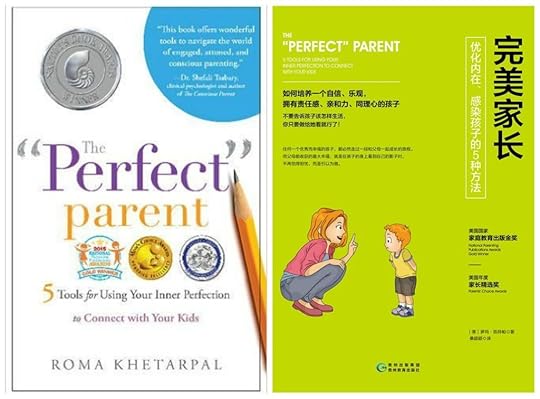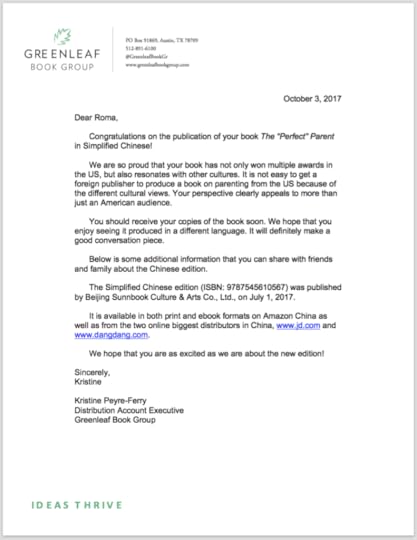Roma Khetarpal's Blog, page 13
December 7, 2017
Are we teaching our kids how to use our most important gifts as humans?

We are definitely different than species of plants and animals. We are the human species – endowed with traits and characteristics that are unique to us and that can help us not just survive but also thrive.
As we parent our children in a constant time crunch, we get caught up with teaching our kids skills to “succeed” in the world that they live in. Academics, extracurricular activities, and social agendas take precedence in our day-to-day routines. We want to make sure that our kids fit in without missing something or feeling left out. Add social media and technology madness to these pressures, and there is hardly any time to focus on anything else.
However, there are some core skills that will help our children succeed no matter what they do. If their self-confidence and self-esteem are well anchored, our kids will be equipped to go through life meeting daily demands and inevitable challenges. To build these core skills, we must look at what clearly separates us from other species.
Our ability to experience. We are gifted with the ability to experience events with both thoughts and feelings. In the busy-ness of raising children, there is so much to be done that we go from task to another on autopilot; we rush from one to-do to the next. To be able to really experience something, we have to use our senses to harness a feeling about that experience.
Say you’re taking your kids to soccer practice. Instead of just dropping them off, take a few minutes to just sit and observe the surrounding greenery. Breathe in the fresh air – even just for few minutes – and pay attention to the sounds you hear. Or when the kids have finished practice, sit on the grass with them for a few minutes and do the same things. These simple actions enlarge the experience. For example, hearing is the task, but listening creates the experience by engaging the senses further and activating the brain and our feelings. Similarly, using your senses to soak in the environment around the soccer field helps create an experience.
Without fine-tuning our ability to truly experience things we are simply robots moving from one monotonous task to the next. As Albert Einstein said, the only source of knowledge is experience. This simple, quick effort will help your entire physical system create a sweet memory, a knowledge that gets attached to the task. In this way, experience leads to …
Our ability to respond. If we add a few minutes to absorb—to be present in—our experience, that sets a tone for how we respond to what happens next. As humans, we have the ability to respond in myriad ways, which truly is activated after we allow ourselves to soak up an experience. This gift is multiplied tenfold if we simply take a pause.
Say you’ve taken a few minutes after soccer practice to really take in the experience. You will immediately notice that you are in a calmer state of mind. Now after you get home, if you and your child are fighting over doing homework and he or she spits out, “I hate you,” you are less likely to react and more likely to respond. Instead of countering with “How dare you,” you’re able to be patient by managing your own emotions first. Why? Because when we slow down and take a break, we release into our system what science calls “happiness chemicals” (dopamine, serotonin, endorphins, and oxytocin).
By slowing down to experience being at the soccer field, you release these chemicals, which can completely change the trajectory of your response. But if you do feel yourself getting angry, you can consciously choose to respond by taking a pause. A pause can allay the stress hormones (adrenaline, noradrenaline, and cortisol) and help you tap back into your reserve of the happiness chemicals. You can even take a few deep breaths before you respond to infuse a fresh dose. The idea is to create a small distance between the outburst your child is having and your response. One simple pause or breath has the power to make us response-able—responsible. And the minute we harness our ability to respond, we can…
Use these new tools to grow. As humans, we have the ability to learn from our experience. No matter how many times we hit repeat on a recurring reaction with our children, the minute we truly experience what is happening and pause or take a breath to respond, we can let go and move on. We might be frustrated, angry or irritated for months because our kids won’t do their homework when they’re told, but the minute we take a step back, we can use our new understanding to generate a new response, letting go of accumulated negative experiences and emotions. This helps us grow and infuses our new experiences with happiness and joy. It nurtures effective communication and stronger connection and relationships with kids and—moving past soccer practice and homework issues—melts away the drama around bedtime and positively affects the quality of sleep – leading to not just a happier life but also to a healthier life. All this stems from a few minutes spent on the soccer field to engage our senses and fully experience what is at hand.
If we are to raise our children to live joyful lives, it is important to talk to them about these innate human gifts and how to use them effectively. We teach by example, and there’s no stronger lesson. Point out to them the pathway of experiences, responses, and new perspectives. If you are spending a few extra minutes at the soccer field with them, let them know why. When you take a pause or a deep breath, explain to them how that helps us manage our emotions and hence our responses. That will help them understand their inner world and gain new tools and the confidence to manage the day-to-day challenges that life presents; self-esteem then follows at its heels. The icing on the cake? It will help your kids be present in the things that they do and also inject some joy into their—and our—lives.
The post Are we teaching our kids how to use our most important gifts as humans? appeared first on Tools of Growth.
November 29, 2017
Did You Complain or Gossip During Thanksgiving?

“Arghh… I’m dreading seeing my in-law. Wish I could outlaw her from our family!”
“My sister is hosting Thanksgiving, but I’m making six dishes! How did that happen?”
“My mom declared it’s her turn to host Thanksgiving, but the new rule is that we all must bring one dish. How come this rule didn’t apply when I hosted last year?”
In the days leading up to Thanksgiving, social media was brimming with resentful emotions—all stemming from grievances during a time that’s supposed to be about celebrating family. How did we get here? Why have we lost sight of the purpose of this holiday? Why are we celebrating “Thanksgiving” with our families if we don’t have an attitude of gratitude?
Our kids are watching. And we all know that kids are great emulators. So give them something worthwhile to emulate. Here are some perspective-shifters that will help us approach the next holiday with a different mind-set while setting some great examples for our kids.
1. Let it go. Whatever your “it” is—past incidents, resentments, grievances, and complaints—dispense with it. It’s time to grow up. We can’t commit to raise our kids when we are not willing to grow up ourselves. Life is short, and we all know that we do not and cannot pick our family. They have entered our life to help us grow. Those who challenge us are as important as those who exemplify compassion, love, and respect. The bigger issue is how to respond. Put your feelings in check. If you can have a conversation with someone about a past issue, do so. If not, let it go. It is neither our job nor responsibility to confront others. Our only responsibility is to manage ourselves. This can easily be done if we…
2. Accept the other as they are and the situation as it is. What keeps this from being our first response is our own expectations of how someone should be or act. If we don’t like how something went or what someone said, we explode in a tornado of resistance: How dare he? Why did she? Who do they think they are? These reactions stem from our not accepting the other person or the situation. Life will never match our expectations. We know that. If it did, how would we grow?
Truly, all we need to do is give up our own illusory expectations so we don’t make ourselves miserable. This can be hard sometimes. So allow the negative feelings to exit your thoughts, emotions and your physical body. If you sit with them in quiet, within 90 seconds they will actually leave your body. In her memorable TED Talk, Dr. Jill Bolte Taylor describes the 90-second rule: “Once triggered, the chemical released by my brain surges through my body, and I have a physiological experience. Within 90 seconds from the initial trigger, the chemical component of my anger has completely dissipated from my blood, and my automatic response is over. If, however, I remain angry after those 90 seconds have passed, then it is because I have chosen to let that circuit continue to run.”
So once the emotion flushes out, consciously choose not to hit repeat. If you are having trouble with this, look deeper and identify your trigger. Chances are that it is some past unmet need or unresolved personal experience that is sparking this repeated response. Now sit and let it work through your system. A mandatory step is to…
3. Bypass the complaining and the gossip. Both of these detrimental habits stem from judgment. Larry Senn, the best-selling author of Up the Mood Elevator, Living Life at Your Best, places judgment at the bottom of our mood elevator. Complaining and gossiping only spirals our mood and our attitude further downward. Who needs to live in a downward spiral when an upward spiral can be achieved by simply choosing not to complain or gossip? Yes, there is value in expressing your emotions when we are disturbed. If that’s the case, and you are truly sharing your feelings instead of judging someone else, find an intelligent, emotionally balanced friend who can be your sounding board. And, please, if you do express your discontent, refrain from doing so on social media.
We have one life to live. Living it well is a choice. To help us grow, life is supposed to throw curveballs, and often they take the form of our family members! Holiday madness is the time to put into practice everything you have learned about personal growth throughout the year. Be smart, and choose your responses wisely to make for a joyful life worth living and sharing. And, of course, remember that your kids are watching!
The post Did You Complain or Gossip During Thanksgiving? appeared first on Tools of Growth.
November 23, 2017
Some Great Tools That Your Kids Will Thank You For
Last week, Tools of Growth founder and author of The “Perfect” Parent, Roma Khetarpal, sat down with Cat and Kathy of the Cat & Kaehler podcast to share parenting tools that your kids will thank you for far beyond this Thanksgiving holiday.
Our children come into our lives to help us grow. The more kids we have, the more opportunity for growth. Take some time this holiday to listen in and build up the communication you have with your kids.
http://latalkradio.com/…/…/files/audio/Catkaehler-112117.mp3
Wishing all our Tools of Growth followers a very happy Thanksgiving.
In Joy!
The post Some Great Tools That Your Kids Will Thank You For appeared first on Tools of Growth.
November 13, 2017
Striking a Balance: Stay-at-Home and Working Moms – Part II

In Part 1 of this blog, we addressed moms who have to work and the emotional challenges of guilt, doubt, and worry that they face. When it comes to time with the kids, the mom who chooses to work—because of a passion or commitment to her profession—deals with the same inner dialogue:
“Am I spending enough time with my child?”
“There aren’t enough hours in the day to get it all done.”
“I didn’t even see my child today.”
“Will I screw up my child?”
“Am I a good mom?”
Besides these questions, however, there are a few more layers of guilt that the mom who chooses to work faces: “Am I being selfish? Am I a ‘bad’ mom for following my passion at the cost of my children?”
No matter how passionate or committed you are when it comes to your profession, this mind-chatter emerges every time you are confronted with a challenge with your child. Here are a few tips that can help you manage these guilt-loaded eruptions.
Get comfortable with your decision: If the decision that you have made is firm and unchangeable, own it. By that I mean, see it as it is and embrace it. Here is a helpful analogy. What happens when you’re on a plane and your child is screaming or throwing a tantrum while the rude passenger next to you is getting annoyed and asking why you can’t shut your child up? Of course, at first you try to calm the child, but at some point, you say to yourself, “Oh, well, my child is uncomfortable (from not feeling good or being tired or afraid or whatever). This is how children behave sometimes. Everyone will just have to deal with it.”
The minute you realize that everyone else’s discomfort no longer bothers you, you can drop the “guilt” of disturbing other passengers and embrace the situation as it is. Instead of focusing your energy on everyone else, you can direct it only to your child. This helps you calm down and handle your child better. Similarly, when you embrace your choice to work with passion and dedication in your profession, you discard guilt and use that energy to make better connections with your child during the time that you do spend with them.
Beyond that, like moms who have to work, as I said in Part I of this blog, you should also:
Make the best use of the time you have with your child; and
Know when to stop and smell the roses.
What about the mom who consciously and willingly decides to stay at home, the “homemaker” mom? Interestingly enough, she has her own inner dialogue (along with feeling a lot of physical exhaustion):
“I’m sick of having my life revolve around kids and home responsibilities.”
“I’m taken for granted.”
“Since I’m home, I’m expected to pick up everyone’s slack and do things they couldn’t get to.”
“I hate it when my husband says, “But you are home all day, how come you couldn’t get to this or that?”
“I need some real-world stimulation!”
This mom is not complaining about not having enough time with her kids but just the opposite: She wants more time off without the kids and home responsibilities! If you are a homemaker mom, here are a few tips:
Count your blessings and tap into the power behind “I choose to” versus “I have to.” Since complaint is your constant companion, move inward, and reflect for a moment on how lucky you are to be able to choose to make this decision. On days that you feel bogged down, take a step back and write down the reason for your choice. Perhaps your decision was based on wanting to be home for the kids while they were young and the importance of that. Stepping back to reflect on why you made that choice is a great balm for any temporary emotional outbreaks. If your kids are old enough and going to school, and you’re feeling like “I need to work,” then find a part-time job, get involved in school, or find a volunteering position that touches your heart. This could surely give you the best of both worlds.
As for others expecting the world of you or taking you for granted, that’s part of being a homemaker mom. You can either complain continuously or roll up your sleeves and in a kind way remind the family that your plate is full with home and child responsibilities, and you can’t get to everything they want when they want it. Let them know that you are happy to be accommodating when you can, and when you can’t, they have to honor and respect your time.
As I mention in my book, The “Perfect” Parent, honor yourself! If you didn’t get to something, don’t drown in guilt. Remind yourself of #1 above.
Motherhood is a gift, not a burden. It is difficult but rewarding. Don’t waste your life on a hamster wheel of complaints; science tells us that neurons that fire together wire together. That means the more we repeat an action, the more we deepen the habit. As we all know, complaining is exhausting mentally, draining physically, and, worst of all, contagious. Don’t put this detrimental habit in the air that your children breathe. If you do, I promise you this will be a habit you will regret passing along – for you, the children and your relationship with them.
Put positive energy into the responsibility that you have taken on, and you will be able to build a strong connection to and relationship with your kids. That is the reason that you chose this stay-at-home role. You certainly don’t want to end up with broken connections and a damaged relationship! What’s the point of that? And know when to stop and smell the roses. A mother who can manage her own emotions can masterfully manage those of her children.
We can always find research that will make us second-guess our decisions and try to tell us what we should and shouldn’t do for our kids. But everything comes down to the life-attitude with which we parent. Whether we have to work, choose to work, or decide to stay at home, that will guide the connection and relationship with our kids.
In Joy!
The post Striking a Balance: Stay-at-Home and Working Moms – Part II appeared first on Tools of Growth.
November 1, 2017
Striking a Balance: Stay-at-Home and Working Moms – Part I

A friend sent me an article in The Wall Street Journal, which was based on psychoanalyst Erica Komisar’s book The Politicization of Motherhood. Komisar points to recent research and strongly advocates that mothers should stay home during their child’s formative years of 0-3. As much as I concur with this, we can all understand that for some moms this might not be realistic and may even be burdensome, especially if they are single mothers or the primary breadwinners of the family.
As I have noted in my parenting workshops and private consultations, moms fall into three main categories: the mom who has to work, the mom who chooses to work, and the mom who consciously and willingly decides to stay at home. Regardless of one’s situation or choice, however, there is clearly one single focal point when it comes to our kids: connection.
With today’s fast-paced parenting lifestyle, no mom—stay-at-home or working— has it easy. Demands are high, schedules packed, and time a precious commodity. Yet we all know that we need time to create connections with our children. When it comes to relationships, no other investment offers the return that time does.
So let’s look at each of these types of moms individually and see what emotions they face and what they can do to simply, practically, and effectively to build connections with their children.
In this two-part blog, I’ll first address the mothers who are already stretched and who may, after reading about Komisar’s work, have to deal with underlying emotions about leaving their children to go to work.
If you’re a mom who has to work, you may be saying to yourself:
“Am I spending enough time with my child?”
“There aren’t enough hours in the day to get it all done.”
“I didn’t even see my child today.”
“Will I screw up my child?”
“Am I a good mom?”
Yes, more often than not you are ridden with guilt, doubt, and worry. As a single mom or the primary earner of the family, much of this arises from the insecurity of not being able to spend enough time with your child and your personal expectations of what your family life should look like. Parenting from guilt, doubt, and worry only adds to the emotion commotion. Our kids pick up on it, and either they start mirroring the emotion back to us in their behavior and/or they play on our weakness. This directly affects our connection and our relationship with them. So what should you do?
Accept the situation as it is, and forget about living in an imaginary world of what things “should” or “could” be like. When we accept things as they are, we take the pressure off ourselves and respond—instead of react—to life without resistance and with clarity. In other words, if you can’t change the situation, then face it. It is what it is! This internal shift alone will jumpstart you into making the best use of the time that you do have. Sure, your children will still continue to complain—that’s their job—but in the long run this will teach them resilience, build their grit, and give them an example of how to live life responsibly.
Make the best use of the time you have with your child, and choose your responses consciously and mindfully. Taking the guilt, doubt, and worry off your plate will definitely free up internal space to make more meaningful connections with your child, despite your limited time. Discuss confidently and openly with your child—age appropriately, of course—your role in providing for the family. This is real life. We have to roll up our sleeves and exemplify productive, realistic leadership for our kids, so we don’t raise a generation of children who lead their lives resisting what has showed up on their plate. I’m including a video (link) of a Facebook Live session that I did for a recent parenting summit. In it, I advocate a simple, time-saving, emotion-balancing, connection-building tool called Take 5. Do this every single day—no excuses—for two weeks, and watch for the transformation in your relationship with your child!
Know when to stop and smell the roses. There’s no question that if you are stretched thin, the spillover on your children will be instant and constant. If you can commit to Take 5 for yourself as well once a day, you will come away rejuvenated and bursting with energy! It will take some practice, but if you invest the time in it – just 5 minutes a day – you’ll be amazed at the result. Research tells us that when we take time to care for ourselves we are more effective at communicating and connecting with our children. Once you’ve mastered Take 5 to dial into your internal compass and rhythm, explore other fulfilling ways to satisfy your soul from my friend and self-care expert, Suzi Lula, the author of The Motherhood Evolution: How Thriving Mothers Raise Thriving Children .
The truth is when moms are overloaded, there is emotional leakage that shows up in our behavior with our children. This will affect the air that they breathe and will shape their personality and then be expressed in their relationships with their peers, friends, co-workers, and their own families.
Remember, you are raising the next generation, and every single step you take toward connection and building a relationship with your child is a step that contributes to their well-being and that of our families and society at large. One thing I can promise you: If you commit to Take 5 every day, within two weeks you will transform your internal emotion commotion, and it will show in your relationship with your kids.
Next week, I’ll home in on what challenges other types of moms face.
The post Striking a Balance: Stay-at-Home and Working Moms – Part I appeared first on Tools of Growth.
October 18, 2017
The “Perfect” Parent is Now Available in Simplified Chinese
Three years ago, on October 1, 2014, my first book, The “Perfect” Parent: 5 Tools for Using Your Inner Perfection to Connect With Your Kids, was published by the Greenleaf Book Group. Thanks to your support, this journey has been full of surprises and unexpected gifts. Besides having received four top industry awards and recommendations by Publisher’s Weekly and Library Journal, I am pleased to announce that my book is now available in Simplified Chinese.

There are approximately 1.4 billion people in China—400 million families—but approximately 61 million young children are left behind in villages and small towns as their parents head to large cities to find work. About 70 percent of these children suffer from anxiety and depression. Clearly, there is no more important time for the message of mindful and conscious parenting in China than right now.
When I first started teaching parenting workshops eight years ago, I told myself that if I could help a single child and family through my work, my purpose would have been well served. I hope that through the message of my book, I am now able to help some of these children and families in China.
Please share the announcement about my book. That way you may also impact another child. Together we could contribute to the future of our world.
Here is the announcement:
The post The “Perfect” Parent is Now Available in Simplified Chinese appeared first on Tools of Growth.
The “Perfect” Parent is Now Available in Simple Chinese
Three years ago, on October 1, 2014, my first book, The “Perfect” Parent: 5 Tools for Using Your Inner Perfection to Connect With Your Kids, was published by the Greenleaf Book Group. Thanks to your support, this journey has been full of surprises and unexpected gifts. Besides having received four top industry awards and recommendations by Publisher’s Weekly and Library Journal, I am pleased to announce that my book is now available in Simple Chinese.

There are approximately 1.4 billion people in China—400 million families—but approximately 61 million young children are left behind in villages and small towns as their parents head to large cities to find work. About 70 percent of these children suffer from anxiety and depression. Clearly, there is no more important time for the message of mindful and conscious parenting in China than right now.
When I first started teaching parenting workshops eight years ago, I told myself that if I could help a single child and family through my work, my purpose would have been well served. I hope that through the message of my book, I am now able to help some of these children and families in China.
Please share the announcement about my book. That way you may also impact another child. Together we could contribute to the future of our world.
Here is the announcement:
The post The “Perfect” Parent is Now Available in Simple Chinese appeared first on Tools of Growth.
October 9, 2017
Teenagers: When to Push, When to Let Go
Guest post by Tools of Growth follower, Carolyn West.

My daughter is a high school senior, and I flip flop daily from being excited for her and all that lies ahead, and nervous because she’ll be leaving home soon. It’s been said that the most important time to be a stay-at-home-parent is during the teen years. I absolutely believe this is true.—not because I need to pack her lunch and lay out her clothes, but because there is so much to teach her before she leaves home for college or the workforce.
My daughter is taking an economics class in school, something I highly recommend for every student. The questions she comes home with have made me realize that we don’t teach our kids many of the life skills they need to flourish in the real world. We have had discussions about mortgages, taxes, and saving for retirement. Filling out the FAFSA forms for financial aid for college was the first time our daughter actually saw how much money we make. We shield our kids from things like that, but if we don’t share how we manage to run a house and home, how will they ever know how to do it themselves?
I wrote a blog post a while ago about teaching kids how to advocate for themselves. The topic comes up frequently during discussions of helicopter parenting. We know we must have our kids speak up for what they want, but we never teach them how. And more importantly, how do we know when it’s appropriate for them to take care of things themselves or when we need to step in and do it for them?
Recently, my daughter was struggling with a class in school. She had decided she wasn’t going to just slide by with an easy senior year schedule, so she chose to take mostly AP classes. One of them was particularly difficult, and after being an A student her entire school career, she was failing this one class. It was disappointing to us, but it was devastating to her. We sat down and talked about it, but the conversation just got us more upset. She insisted she would study harder and do better. She was sure she could get the grade up. We suggested a tutor, but she wasn’t going for that. We were unsure if anything had been resolved.
A few days later, she got another test back. She had failed that too. Then she sat down with me and said, “Mom, I think it’s time for a tutor.”
It was time.
We looked at each other and wondered who would act first. She wanted me to call around. I wanted her to do it. I could have easily called a tutor and arranged a session for her but I knew that this time next year when she was away at college the same thing might happen. What if she were struggling with a class? What if she really needed some extra help? I wouldn’t be around to make the call. Nope… she had to take the initiative.
She wasn’t happy about it, but she did it. She called a tutor and set up a time to get help.
And if she hadn’t made the call? Chances are I would have done it. There is definitely a time to step in and get your kids the help they need, but it’s better if we teach them how to do it for themselves. Part of our job as parents is to be the life guide our kids need to get them where they want to go.
One of the tools from The “Perfect” Parent, Guide and Step Aside, fit this situation perfectly. I know my job is to guide my kids in the right direction and help when needed, but then to step aside and let them made some of those hard decisions for themselves. That’s not helicopter parenting, that’s good parenting.
Carolyn blogs at This Talk Ain’t Cheap. and is the Co-Founder of SoCal Lady Bloggers.
The post Teenagers: When to Push, When to Let Go appeared first on Tools of Growth.
October 5, 2017
Talking to Kids About the Las Vegas Shooting
With so much pain from the Las Vegas shooting this week, we are all trying to cope with what happened and our immense grief and fear. Roma sat down with Alex Urbina and Kyle Jellings on KHTS AM-1220 Radio in Santa Clarita to give us some tips to help us discuss this tragedy with our kids, and how to handle it ourselves as well.

http://toolsofgrowth.com/wp-content/uploads/2017/10/roma-interview-oct2-2017-1.mp3
Some of the key takeaways from the discussion:
Be honest: Face this with acceptance. Let kids know that, yes, bad incidents do happen. Open up a discussion.
Address what everyone in the family is feeling, and discuss it. Allow time to process this. Do a Dealing with the Feeling (Spot it; say it; okay it.)
Make your kids feel safe and secure. They are looking to us for safety. Limit the exposure to the disturbing content.
Recognize that events like these come from a complete disconnection from oneself and our innate human values of goodness and oneness.
Mindless events like these are caused when we do not understand what our inner world looks like. It’s important to educate children on what being mindful is.
Go inward and raise the level of awareness and connection— through meditation or breathing exercises—with ourselves and with those that we interact everyday: our family, peers, community.
When something so massively damaging happens, the elevation of human compassion increases tenfold.
Reach out and offer your help. Healing is best expressed through acts of connection, kindness, and compassion.
Learn more from Roma about talking to kids about violence at Tools of Growth and 30Seconds.com.
The post Talking to Kids About the Las Vegas Shooting appeared first on Tools of Growth.
September 21, 2017
College Bound? A Parent’s Growing Pains

“I see my daughter packing to leave next week. She’ll be leaving home for the first time, and my stomach is churning.”
“I’m a little nervous for Oliver. He’s off to college, and he still looks like he’s 15. I hope he doesn’t get bullied. How will he handle living on his own?”
“Anila is going to college. Oh, my God. I’m totally stressed out. She’s always attracted to the wrong crowd, and now I’ll have no control over that.”
“Liam is off to college. I know he’ll be fine, but my heart hurts.”
“We are dropping Jay off at USC tomorrow. He’s ready but I’m not.”
What is this strange connection we have with our kids? Either we seem to take on their anxiety or we have our own. Why is the parenting ride full of moments like these?
For one thing, there’s always a little angst attached to entering the unknown, no matter what stage of life we’re entering. That’s human nature. Facing something new, we get the jitters, and fear creeps up on us. And we all know how fear can snowball into anxiety, stress, and nervousness. But there are some things you can do:
Cultivate your Emotional Intelligence. By definition, EI is the ability to recognize and understand your feelings and those of others. So manage your feelings intelligently. If you are the one who is stressed, sit with the emotion and break it down by Dealing with the Feeling:
Spot it (spot the feeling—anxiety, stress, fear).
Say it out loud in a full sentence—I am feeling stressed, nervous, or anxious because my son is going off to college, and I feel he is still irresponsible, or because I will be lonely (whatever the case may be).
Okay it—It’s ok for me to feel this way, because I’m entering unknown territory, and it’s human nature to be anxious when we begin new phases or stages of life.
The only way to deal with feelings is to embrace the discomfort. Don’t distract yourself or drown yourself in it. Take the middle road. Let the feeling come through, and then watch it pass through your body. Jill Bolte Taylor states that it takes 90 seconds for the chemical reaction behind a feeling to work its way through your system. Make time for that to happen. Sit in silence, and observe the discomfort lose its power over you.
If your fear is for your child, for example, because they are irresponsible, well, you knew that last year, six months ago, last month, and last week. Being anxious about that now is not going to change anything. Many kids learn best when they are in the line of fire. Let them fall and learn. Failure and mistakes are the best fertilizers for growth. And we all want our kids to grow. So focus on staying connected and communicating. Have a little faith—or a lot of faith. Then…
Trust and surrender. It’s time to give up control. Control is the antithesis of growth and development. The more we control our kids, the more out of control they get. If you don’t give up control, you are doing a disservice to your kids and preparing them for failure not success.
I’ll point to the ending of my book, The “Perfect” Parent . In the last tool, Enjoyable and Memorable Parenting, I note: “We spend the prime years of our lives grooming our children for their grand, independent entry into the real world. This is the moment we have prepared for all these years. And when it arrives, we want to feel that this truly is just the beginning of a different phase of our relationship with our perfect precious ones. We want to be confident that we have done well, and to trust that they will do well. That’s really all that every parent wants for their kids.”
So trust your kids and yourself. If you are an involved parent who is present and mindful, you will be there to help them when they fall. And if they don’t call upon you, even better. Bravo! You’ve taught them how to make mistakes and figure it out on their own.
As hard as it may sound, the best thing we can do for our kids as they embark on adulthood is to let go. That does not mean you should not keep in touch with them but rather you should guide and step aside. Surely you have guided them well thus far, to the doorstep of their next phase of growth. Now it’s time to step aside so that they may get to know themselves out of your shadow, consciously and mindfully, in their own light.
The post College Bound? A Parent’s Growing Pains appeared first on Tools of Growth.




